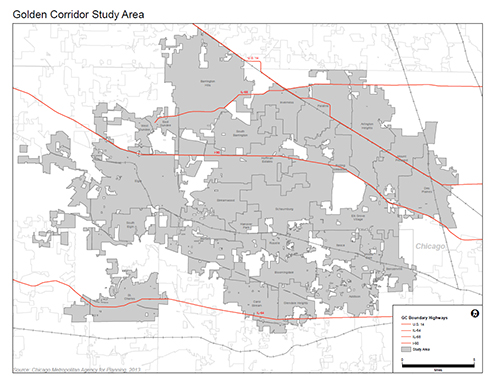Update: This project was completed in January 2014.
Manufacturing is the largest industry in the Golden Corridor, an area near and around the I-90 corridor. Though manufacturing continues to be the area's top employer, the industry has experienced significant decline in employment over the past ten years. In 2002, approximately 113,000 people worked in manufacturing in the Golden Corridor. By 2012, however, the number of manufacturing employees in the area decreased by 25 percent to about 85,000. This decline in manufacturing is not unique to the Golden Corridor – over that same ten-year period manufacturing employment declined by 22 percent in the seven-county region and by 20 percent nationally. Despite the loss in employment, productivity in manufacturing has increased. As manufacturing is becoming more efficient and innovative, employers are requiring higher skilled workers than in the past. Many educational institutions, students, and parents, however, are not aware of the modern manufacturing field and may not consider it a viable career path due to historic perceptions of manufacturing that are no longer true.

In 2009, the Village of Hoffman Estates helped form the Golden Corridor Advanced Manufacturing Group (GCAMG) to represent and organize manufacturing stakeholders in the area. With the help of CMAP's Local Technical Assistance (LTA) program, the GCAMG is seeking ways to expand and develop programs and resources that expose students and their parents, as well as school administrators, to the newly evolved manufacturing field and its career opportunities. More manufacturers are reinvesting and expanding operations in the U.S., creating significant opportunities for the economy of metropolitan Chicago to fundamentally alter the next decade of manufacturing. The sustainability of the GCAMG is an important goal, and this LTA project will include a strategic plan for long-term viability of a partnership between GCAMG and other stakeholders involved in workforce development, education, and economic development.
With these goals in mind, this project will result in three deliverables:
- An existing conditions report that identifies specific types and sizes of manufacturers in the Golden Corridor and provides an overview of the existing economic and workforce development initiatives in the area, including programs at community colleges, local high schools, manufacturing facilities, community based organizations, and local and regional economic development organizations.
- A communications plan to help GCAMG establish and expand relationships between manufacturing employers and educational institutions (defined here to include school staff and administrators, students, and their parents). The plan will provide strategies to increase student and parent awareness of the manufacturing field and increase student contact with manufacturing as a career opportunity.
- A strategic plan to form sustainable industry partnership that will identify sustainable funding and other resources to support GCAMG's sustainability, as well as priorities and strategies for the partnership to organize around. The intermediary will help create lasting connections between employers and educational institutions.